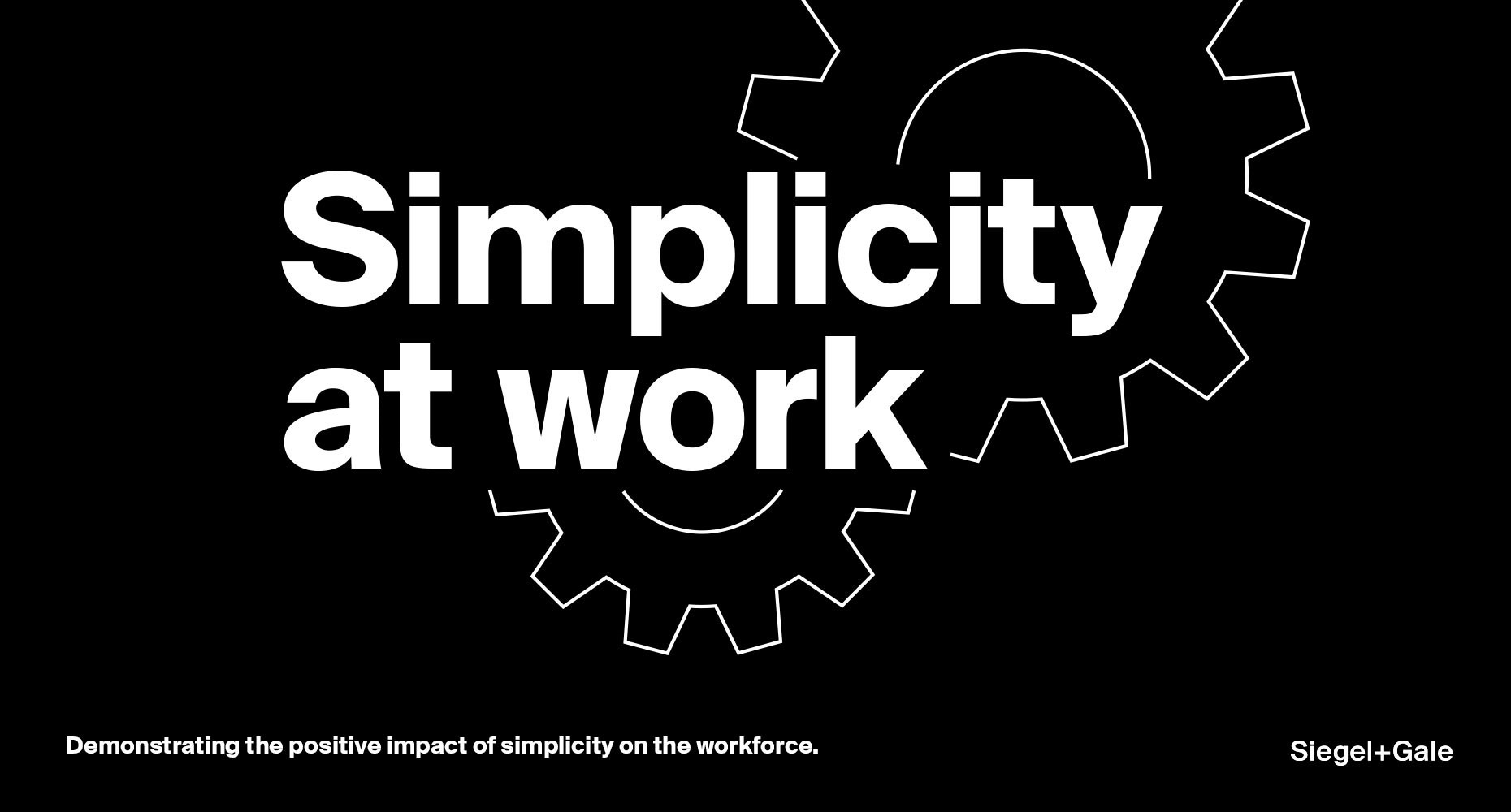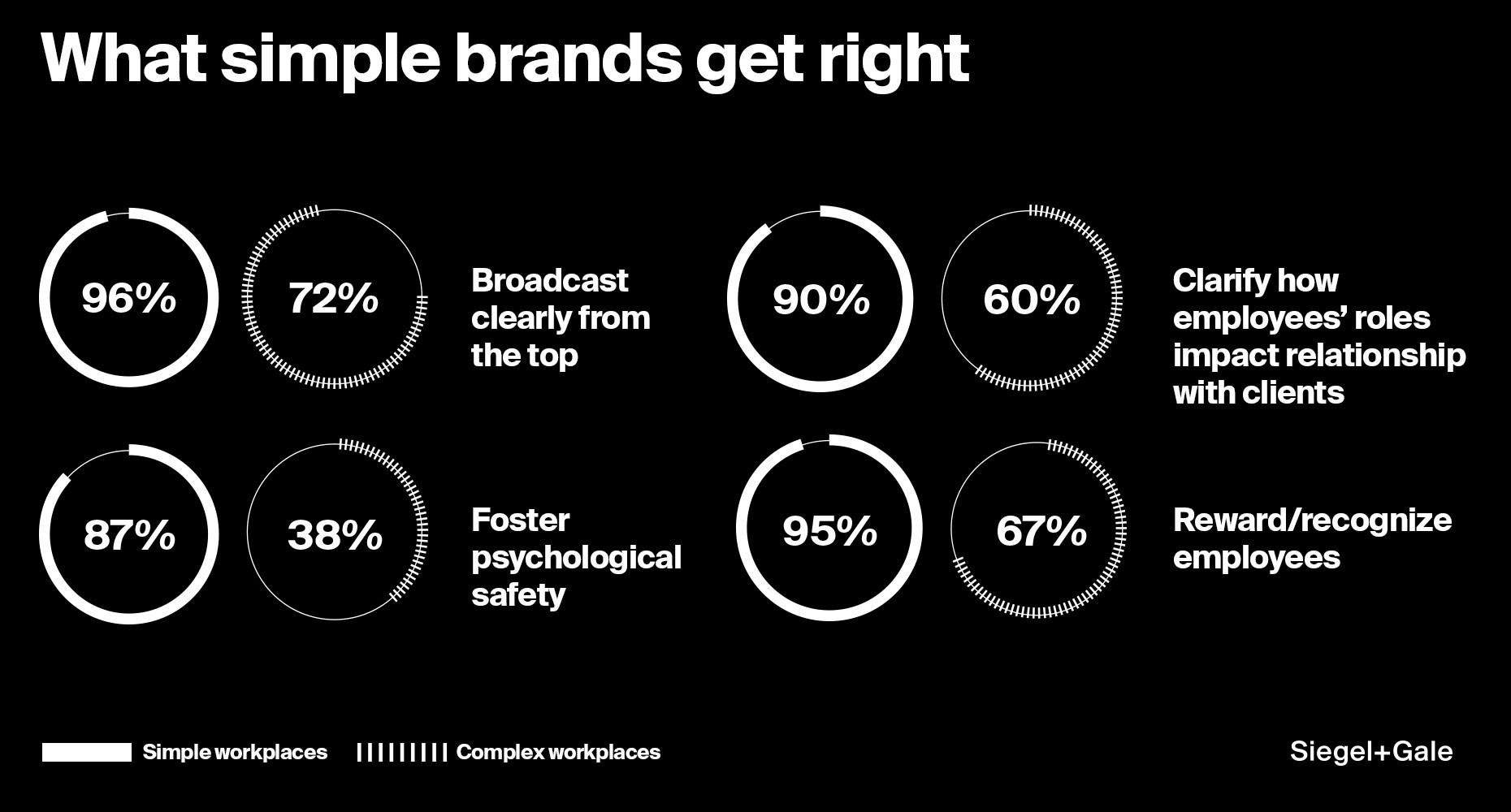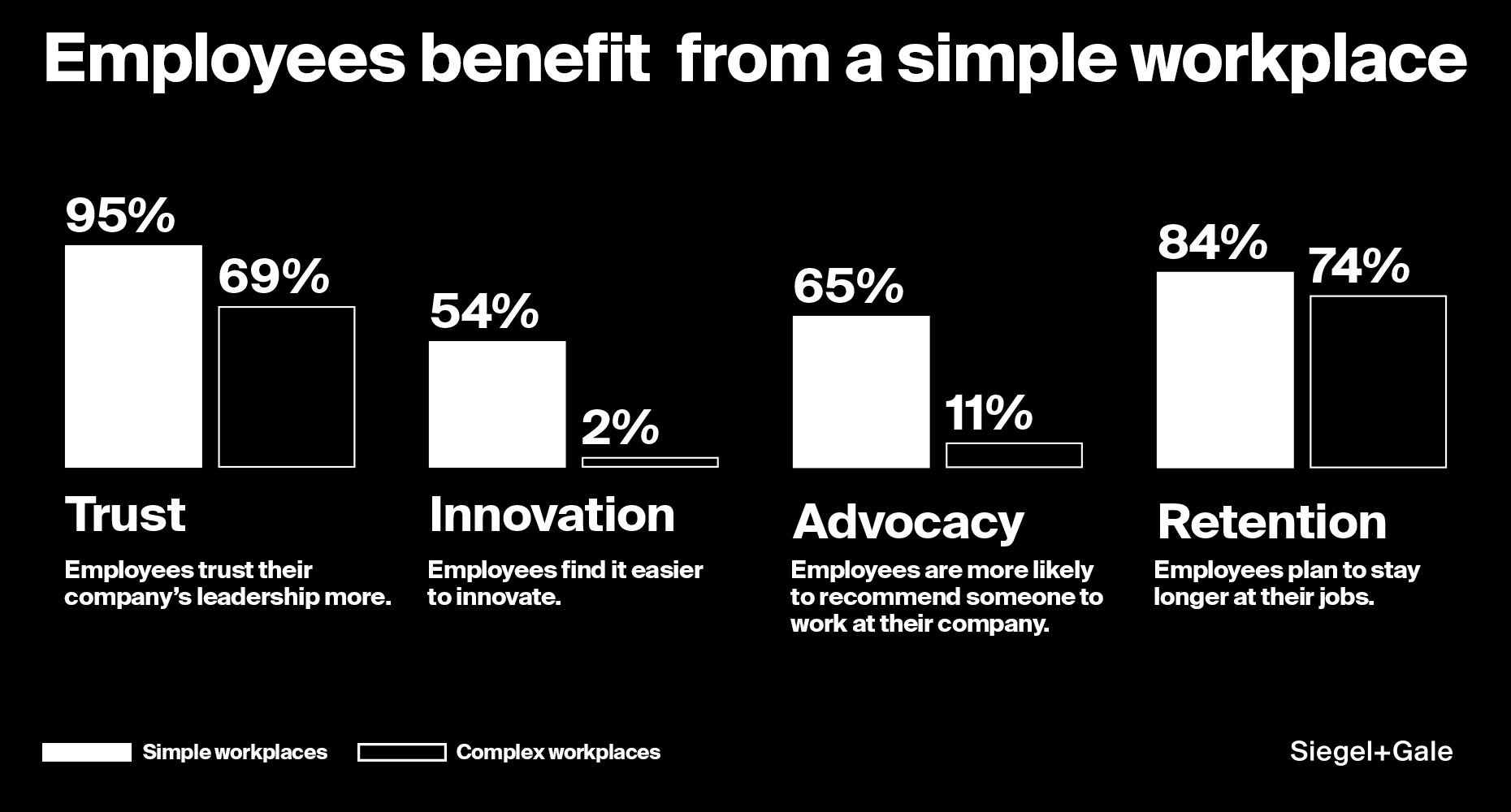Why brands should embrace simplicity

Global branding firm Siegel+Gale has been a vocal advocate for brand simplicity since the firm was founded in 1969. But, in an increasingly complex and multi-channel world, why should brands, organisations and workplaces retain a simplistic approach? We look at Siegel+Gale’s latest employee engagement survey, examine the Global Brand Simplicity Index 2017 and hear from associate strategist, Toby Marks.

How simple workplaces foster engagement – insights from the Siegel+Gale Simplicity at Work study 2017
Global branding firm Siegel+Gale has released the results of its latest employee engagement survey, ‘Simplicity at work.’ As suggested in its ‘Demonstrating the positive impact of simplicity on the workforce' subheading, the report’s finding indicate that the more structurally complex an organisation, the more the organisation is at risk of losing trust, advocacy and innovation among employees. However, the report also highlights the touchpoints at which companies can begin to make real change while enhancing the employee experience across all facets of an organisation.
Surveying 14,000 people across nine global organisations, the results provide important insight into the constraints complexity can deliver. “Our new study shows organisations that don’t prioritise employee engagement risk losing talent, reducing overall team productivity and ultimately negatively affecting business results,” says Philip Davies, EMEA president at Siegel+Gale. Yet, continues Davies, the organisation itself can be the cause of its own destruction. “What makes employee engagement so difficult to realise? Our research shows that complexity is the biggest inhibitor. If a company invests in simplifying their workplace, they will benefit from greater trust, advocacy, innovation and retention among employee.”
And, continues Davies, the solution is relatively straightforward – simplicity. For new recruits, clarify your company or brand purpose from the offset; develop a clear management structure and take a straightforward approach to employee engagement and brand management. This, says Davies, is more likely to engage employees and encourage them to act in company interest, rather than navigate a complex company network. “At simple organisations employees are more likely to become brand champions because they understand and are committed to what their company stands for,” says Davies. “Building company culture through simple experiences at work is critical. Simplicity is a topic moving rapidly up the boardroom agenda – the stakes are too high to overlook this opportunity.”
However, the achievement of workplace defined by simplicity is an ongoing process. The report therefore details other practical steps an organisation can take to mitigate the negative impact of complexity. Perhaps most important is to get the facts, says Siegel+Gale. “Engaging employees can be a nebulous undertaking, but building a fact base helps identify the factors that influence (or detract from) engagement,” details the report. “Tying employee brand alignment to desired business results helps to rationalise investments in the employee experience and in employer branding programs. Once programs are in place, track and measure success.”
The report also suggests leading with purpose and defining your employer value proposition, which instils a sense of cultural belonging into the workforce. Encouraging employees to strive for a purpose greater than profit is integral to wellbeing and contentment – “Together, your brand purpose and employer value proposition become a decision-making filter to simplify operations, shift your culture and create sustained change,” says Siegel+Gale. Finally, says the report, go back to simplicity. When employees can see their position aligned with business goals, there’s greater impetus to work hard and achieve more – “Make it easy and rewarding for employees to do their jobs.”


To optimise a customer’s brand experience, a brand must clarify its message, purpose and positioning before launching a product or service.
Each year, Siegel+Gale releases its annual Global Brand Simplicity Index (GBSI). Aiming to answer the questions, ‘What’s the value of simplicity for the world’s leading brands?’ the index provides a unique insight into consumer attitude toward brands across the world. “Simplicity is the ultimate driver of brand loyalty,” says Siegel+Gale; nowhere is this more demonstrable than in the statistics.
Insights abound, such as 64% of consumers being willing to pay more for a simplified brand experience; 61% are likely to recommend a brand because it provides simpler experiences and communications. Perhaps most startling, however, is how brands continue to sacrifice around $86bn through not simplifying. The fiscal implications of running continually complex operations are plain to see across global markets, yet vary vastly according to geographical location and culture.
In the 2017 GBSI, Aldi, Lidl, Google, Netflix and KFC stood out as some of the world’s least complex brands, laying out their customer value, employer value proposition and brand purpose clearly and effectively. At the other end of the scale, however, global insurance company AXA takes the bottom spot for a consecutive year, followed closely by Bupa, LinkedIn, Avis and MetLife. It could be argued that, given the perceived intricacies of tech, leaders in the space have worked hard to develop products which are user-friendly and accessible. Food and drinks brands are also prevalent, perhaps suggestive of their reliance on the simple but effective concept of communicating via the senses. On the other hand, the bottom of the scale is dogged by insurers and service providers with hidden fees, confusing adverts or an opaque brand offering. Customers are less likely to remain loyal to brands which are prone to shift and change with each individual experience – particularly if their offering is unclear from the beginning.

Crafting a strategy which goes beyond simply acknowledging simplicity and uses it as a measure of the entire brand experience can mean the difference between success and failure. Toby Marks, associate strategist at Siegel+Gale, explains why brands shouldn’t be afraid to embrace simpler concepts.
My Amazon Kindle is one of the most delightful items I own. A single-purpose gadget with an industrial design ethos that, in its singular focus on the purity of e-reading, delivers page after page of content without distraction. Unlike other readers, it offers a complete experience for the customer and as CEO, Jeff Bezos declared on its launch 10 years ago, ‘This isn’t a device, it’s a service.’ An extension of Amazon’s brand, it builds on its DNA. ‘New solutions to make things easier, faster, better, and more cost-effective.’
Many over-excited designers and marketers would be well served to take an e-leaf out of Kindle’s book. Many in their quest to jump on the brand experience bandwagon in search of experiential delight end up serving a dizzying mixture of noise, clutter and brand fragmentation.
Topshop’s summer storefront spectacle, a virtual water park-cum-virtual reality initiative served as a sugary, soft-serve experiential treat to entice consumers into its store and purchase swimwear. Touted as being technologically advanced, immersive, shareable, celebratory and retail theatre exhaustively rolled up into one, it’s safe to assume an all-engulfing and gaudy experience. The Topshop brand, and in particular this execution, seems to lack the focus and direction needed to deliver clear, human and useful experiences. Overly-influenced by today’s zeitgeist and blind to the benefits of simplicity, complexity is baked into every part of Topshop’s DNA.
Testament to this, Siegel+Gale’s 2017 Global Brand Simplicity Index saw Topshop slip in at a lowly 77. We also found that 61% of people are more likely to recommend a brand because it provides simpler experiences. This means that while a VR slide seems cutting-edge and playfully engaging, the addition of such chaotic new ways to shop will inevitably add complexity and alienate existing customers.
Translating the brand into an ‘on-brand experience’ is an exercise in filtration. Ideas should be met with the essence of the organisation, what it represents and how it represents itself, and filtered based on fit. That’s not to say each idea that fits should be implemented. One truly memorable experience at any given touch point is better than three that serve as distractions and dilutions of the initial desired result.
Simplicity creates the foundations for good brand experience; clear, human and useful experiences cut through competition and meet customer’s desires. It’s the understanding of these principles and the correct manner to apply them that facilitates a memorable experience and drives brand loyalty.
As brands scramble to remain relevant and reactionary, the desire to add more needs to be careful considered. Winning the hearts and minds of consumers will require the brand to have an intricate understanding of why they do what they do and from that, how to filter the truly memorable from the momentary delight. In the face of competition adding more, bold decisions to embrace simplicity will be hard to make, but the return will be worth the investment.
Toby Marks is associate strategist at Siegel+Gale












